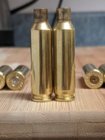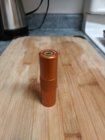Hey guys!
This is my first post on this forum. So many questions have already been asked and answered here, but I could really use your collective experience and knowledge on my specific problem.
So, long story short: I am brand new to reloading. I have recently bought all the basic equipment to get started (I think) and in my excitement over all these new tools I have started to measure and weigh everything in my shooting cabinet. I am the proud owner of a Bergara B-14 HMR chambered in 6.5 Creeedmoor and I was a bit surprised when none of the brass from that rifle (once fired) would fit in my "Go - No Go" Ammo checker from Lyman.
Looking closer, I noticed a circumferential bulge on the body of the case near the head. This rifle has only ever fired factory ammunition and interestingly, the bulge is at a very slightly different height depending on the brand of the brass.
I believe you will be able to see what I'm trying to explain on these photos.
The 4 cases on the left are from Hornady ammunition, the ones to the right from Nosler.

On this one at the left and right are still Hornady and Nosler. Put side by side you can see that there is a line slightly higher on the Hornady compared to the Nosler, and it also shows the bulge where the two cases touch.

This shows how a non fired round fits nicely in the Lyman ammo checker while the fire formed brass is too big. According to Lyman, the ammo checker is manufactured to the minimum SAAMI specs of a 6.5CM chamber.


When I compare the measurements I took from a fired case to the SAAMI specs they are over sized for the maximum cartridge size but they are still smaller than the maximum chamber specs. In my research I have found photos of very similar cartridges but most people seemed to attribute the deformity to the reloading process. Something like "this line is where your full length resizing die ends". The thing is: these cases have never been in a press since they were bought.
(So much for the short story)
Finally, this is what I would like to know:
About my rifle: Do you think my rifle's chamber is out of spec? If so, should I expect this to affect my accuracy potential a lot?
About my brass: Can I safely reload this? Is it going to work harden this spot faster? Weaken it? Should I just neck size and leave the case head alone?
I'm bummed. I really like that gun and it is the main reason I wanted to start hand loading.
Your input is much appreciated. I have so much to learn.
Thanks a bunch!
XCCat
This is my first post on this forum. So many questions have already been asked and answered here, but I could really use your collective experience and knowledge on my specific problem.
So, long story short: I am brand new to reloading. I have recently bought all the basic equipment to get started (I think) and in my excitement over all these new tools I have started to measure and weigh everything in my shooting cabinet. I am the proud owner of a Bergara B-14 HMR chambered in 6.5 Creeedmoor and I was a bit surprised when none of the brass from that rifle (once fired) would fit in my "Go - No Go" Ammo checker from Lyman.
Looking closer, I noticed a circumferential bulge on the body of the case near the head. This rifle has only ever fired factory ammunition and interestingly, the bulge is at a very slightly different height depending on the brand of the brass.
I believe you will be able to see what I'm trying to explain on these photos.
The 4 cases on the left are from Hornady ammunition, the ones to the right from Nosler.

On this one at the left and right are still Hornady and Nosler. Put side by side you can see that there is a line slightly higher on the Hornady compared to the Nosler, and it also shows the bulge where the two cases touch.

This shows how a non fired round fits nicely in the Lyman ammo checker while the fire formed brass is too big. According to Lyman, the ammo checker is manufactured to the minimum SAAMI specs of a 6.5CM chamber.


When I compare the measurements I took from a fired case to the SAAMI specs they are over sized for the maximum cartridge size but they are still smaller than the maximum chamber specs. In my research I have found photos of very similar cartridges but most people seemed to attribute the deformity to the reloading process. Something like "this line is where your full length resizing die ends". The thing is: these cases have never been in a press since they were bought.
(So much for the short story)
Finally, this is what I would like to know:
About my rifle: Do you think my rifle's chamber is out of spec? If so, should I expect this to affect my accuracy potential a lot?
About my brass: Can I safely reload this? Is it going to work harden this spot faster? Weaken it? Should I just neck size and leave the case head alone?
I'm bummed. I really like that gun and it is the main reason I wanted to start hand loading.
Your input is much appreciated. I have so much to learn.
Thanks a bunch!
XCCat















